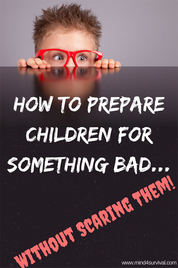|
By Brian Duff  How to Prepare Children without Scaring Them! Do you know how to prepare children for something bad without scaring them? Just like their parents, children are often scared of the unknown or unfamiliar. Because of their fear, it’s important that you take the time to explain the dangers they may encounter. If you do, your children will become more familiar with their vulnerabilities. This increased familiarity will help them to be less afraid. As they become less afraid, they will also become safer, more secure, and better prepared. Avoid Scare Words and Tactics When discussing various problems with your children, it is best to avoid scare words and tactics. Scare words and tactics may cause anxiety and fear, which take away from the learning experience. For example, avoid telling your child, “You’ll die if…” Also, since child abduction is often a concern, try to avoid phrases such as “The man will get you…” Instead, try to think about the intent of what you are saying. If it’s to make a scary point to convince your child not to do something, it may be better left unsaid. Remember, the goal is to prepare children for something bad without scaring them. Use Positive Reinforcement Instead of using scare words and tactics, focus on using positive reinforcement. You can achieve positive reinforcement by using simple terms to explain what makes a particular situation unsafe. When explaining why they shouldn’t speak with strangers, try telling them it’s because mommy doesn’t know the person. Doing so can establish a real, practical but non-scary reason in your child’s mind for not speaking with strangers. Create a Plan Once your child understands the lesson you are teaching, have a discussion with them about what to do if he or she finds himself or herself in that situation. For example, the National Crime Prevention Council suggests teaching children “No, Go, Yell, Tell” (NGYT). NGYT is a course of action for children to follow when a stranger approaches. If approached, they should say “No,” then “Go” (run away), “Yell” as loud as possible, and lastly “Tell” an adult. Act It All Out After teaching your children what to do, role playing the situation with them reinforces everything. By acting out the lesson, you are not only reinforcing it, but you are also doing it in a way that is fun and not scary. So, play the part of the stranger and have your child act out the NGYT process. Have him or her act it out with another adult playing the same role, so it adds to the overall fun. Make it more fun by having everyone overemphasize their actions. Doing so will help your child retain the information and preparing for when a stranger approaches. You Set the Example An important point to remember is that you are the model for your child. Therefore, if you regularly speak with strangers, your kids will pick up on this and think it is okay. However, if you do have to talk with a stranger, you should explain why it is okay in that particular situation. Maybe it is okay because the stranger is also a mommy in the shopping mall with her children. Perhaps it’s okay because you and your child were together rather than alone when the conversation occurred. Maybe the stranger is a uniformed police officer or firefighter, who are good people. Impress Your Family’s Safety and Security Values Lastly, it is important to impress your family’s safety and security values and rules upon your child. As you do, make the most of non-scary, teachable moments to reinforce your lessons. Take advantage of the everyday opportunities to explain and teach things to your children. Doing so will help your child’s sense of security, safety, and preparedness evolve as he or she grows. It will also provide them with the foundation they need when they’re older to pass on your safety rules to their children. Teaching Your Child Takes Thought, Time, and Dedication In the end, learning how to prepare children for something bad without scaring them isn’t hard. It just takes thought, time, and dedication. Think about ways to prevent your lesson from being scary. Once you’ve thought it through, take the time to explain the issue. Reinforce your lesson by acting out the scene with your child in a fun way. Lastly, stay dedicated to finding new ways to reinforce lessons that will lead to a safe, secure, and prepared life. When you do, you will help prepare children for something bad without scaring them. Lastly, never forget, you’re just one prep away. If you have any other information, suggestions, or thoughts on how to prepare children for something bad without scaring them, please leave a comment below. Stay safe, secure and prepared.
0 Comments
Leave a Reply. |
|

 RSS Feed
RSS Feed
